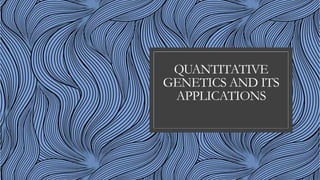
Quantitative Genetics And its Applications.pptx
- 2. Contents ◦ Types of Traits. ◦ Quantitative Genetics. ◦ Assumption for effective observation of phenotype in quantitative genetics. ◦ Application of Quantitative Genetics in Plant Breeding.
- 3. Types of Traits Qualitative Traits Quantitative Traits
- 4. Types of Traits Qualitative Traits Described according to kind. Discontinuous Variation. Monogenic/Oligogenic. Related with Individual Mating and their progenies. Estimation based on counts and ratios. Form (Round/Wrinkled), Coat color of Guinea pig(Black/White) etc.
- 5. Types of Traits Quantitative Traits Described in term of degree of expression. Continuous Variation Polygenic Population of individuals comprises diversity of mating kind. Estimates of population parameters using statistical tools. Skin Color, Seed color of wheat, Ear size of maize, etc.
- 6. Types of Traits Difference On Qualitative Traits Quantitative Traits Nature of Traits Described according to kind. Described in term of degree of expression. Scale of Variability Discontinuous Variation. Continuous Variation. Number of Genes Monogenic/Oligogenic. Polygenic. Mating Pattern Related with Individual Mating and their progenies. Population of individuals comprises diversity of mating kind. Statistical Analysis Based on counts and ratios. Estimates of population parameters using statistical tools. Examples: Form (Round/Wrinkled), Coat color of Guinea pig(Black/White) etc. Skin Color, Seed color of wheat, Ear size of maize, etc.
- 7. Quantitative Genetics ◦ Branch of genetics dealing with the quantitative traits. ◦ Influenced by multiple genes as well as environment that plays a significant role in the expression of traits. ◦ Aims to understand and predict the inheritance pattern of quantitative traits. ◦ Estimating the relative contribution of genetics and environment factors to the phenotypic expression.
- 8. Assumption for effective observation of phenotype in quantitative genetics. ◦Reference population defined. ◦Absence of linkage. ◦Presence of diploid Mendelian inheritance. ◦Absence of selection during the formation of inbred lines. ◦No breeding of the reference population.
- 9. Application of Quantitative Genetics in Plant Breeding. ◦Selection of Quantitative Traits ◦Trait Evaluation and its variation ◦Trait Improvement through Genomic Selection ◦Germplasm Evaluation and Utilization ◦Hybridization and Hybrid Vigor ◦Breeding Value Estimation
- 10. Application of Quantitative Genetics in Plant Breeding. Selection of Quantitative Traits ◦ Used to select for quantitative traits that are difficult to measure directly, such as disease resistance or drought tolerance. ◦ Uses indirect selection, which involves selecting for correlated traits that are easier to measure, but which are genetically linked to the desired trait.
- 11. Application of Quantitative Genetics in Plant Breeding. Evaluation of Traits and its Variability ◦ Allows breeders to estimate the heritability of quantitative traits. ◦ Helps to estimate the proportion of the phenotypic variation that is due to the genetic factors. ◦ Know the contribution of genetic and environmental factors to the phenotypic variation observed in these traits. ◦ Traits with high heritability are more likely to respond to selection, allows to focus on those traits.
- 12. Application of Quantitative Genetics in Plant Breeding. Trait Improvement through Genomic Selection ◦ Done through marker-assisted selection, where molecular markers linked to desired traits are used to screen large populations and select plants with the desired genetic makeup. ◦ Accelerates the breeding process by allowing early selection based on genetic potential.
- 13. Application of Quantitative Genetics in Plant Breeding. Hybridization and Hybrid Vigor ◦ Plays a role in understanding and harnessing hybrid vigor. ◦ Can develop hybrid combinations that exploit heterosis (hybrid vigor) for improved yield, disease resistance, or other desirable traits by understanding the genetic basis of complex traits. ◦ Used to predict the performance of hybrid combinations based on the combining ability of parental lines.
- 14. Application of Quantitative Genetics in Plant Breeding. Germplasm Evaluation and Utilization ◦ Enables the assessment of genetic diversity within germplasm collections. ◦ Studies the genetic variation and trait performance of different crops, ◦ Allows to identify valuable genetic resources and incorporate them into breeding programs ◦ Creates novel traits or enhance genetic diversity.
- 15. Application of Quantitative Genetics in Plant Breeding. Breeding Value Estimation ◦ Allows breeders to estimate the breeding value of plants, which represents their genetic merit for a specific trait. ◦ Estimation considers both the individual's own phenotype and the genetic information of its relatives. ◦ Helps breeders make informed decisions about which plants to use as parents in breeding programs.
- 16. Application of Quantitative Genetics in Plant Breeding. In short, Scientific framework, to understand 1. Genetic architecture of complex traits. 2. Select superior plants, 3. And accelerate the development of improved cultivars with enhanced agronomic traits, productivity, and adaptability.
- 17. Thank You!